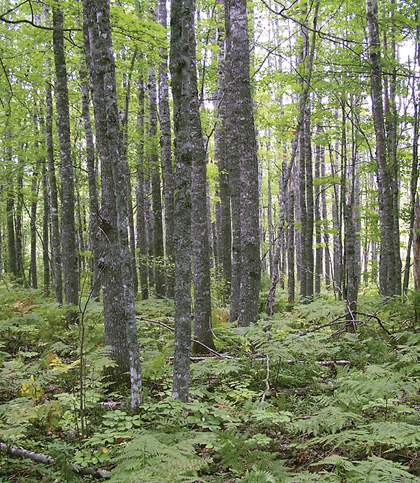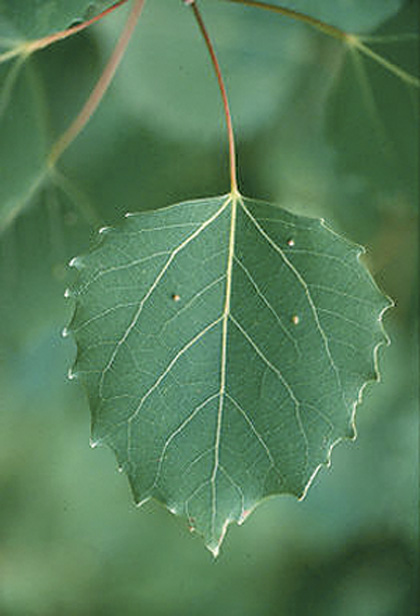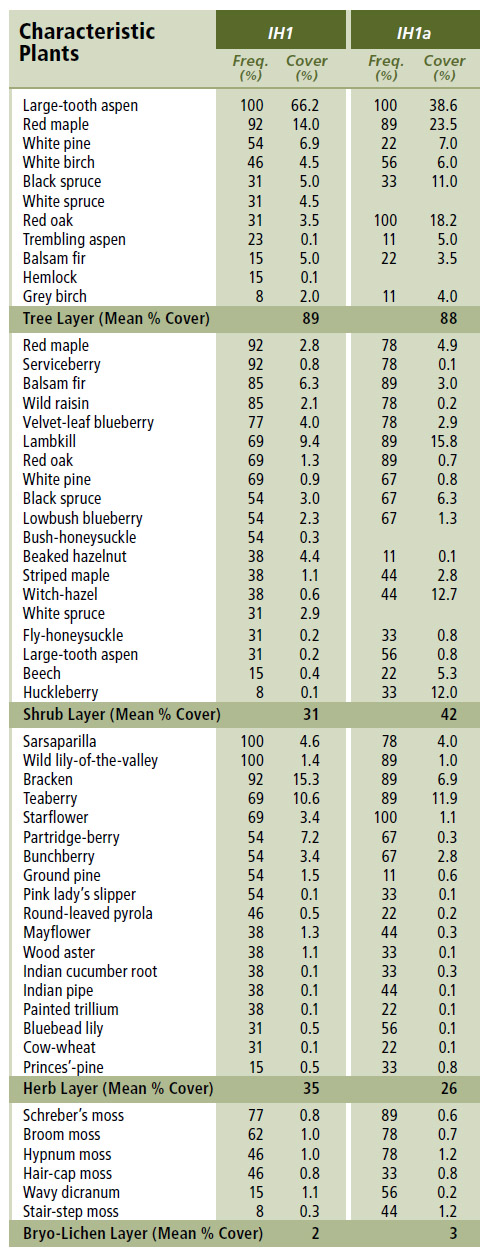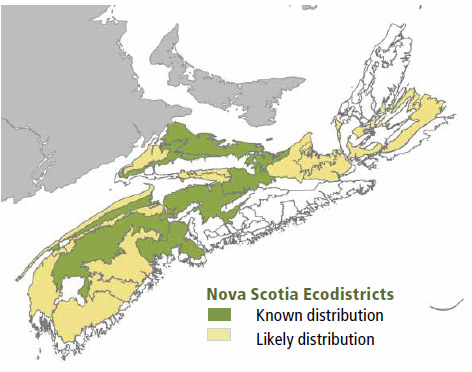
Forest Vegetation types - IH1
IH1 — Large-tooth aspen / Lambkill / Bracken
Populus grandidentata / Kalmia angustifolium / Pteridium aquilinum
IH1a —Red oak variant
Quercus rubra
 |
Black River Road, Cumberland County |
Concept: This early successional Vegetation Type (VT) has an overstory dominated by large-tooth aspen accompanied by a strong component of red maple. The IH1a variant describes stands where red oak is a significant part of the overstory. IH1 has a well-developed understory of disturbance-tolerant woody and herbaceous plants, but reduced bryophyte cover. Large-tooth aspen / Lambkill / Bracken usually follows stand-replacing disturbance events such as fire, windthrow or clearcutting. Most large-tooth aspen originates as vegetative regeneration from root suckers.
Vegetation: Large-tooth aspen and red maple are dominant overstory trees, but the latter species is usually less abundant. White birch, white pine and red oak are common associates – with red oak co-dominant in variant IH1a. The shrub layer is well developed, including wild raisin, serviceberry, velvet-leaf blueberry and bush-honeysuckle. The presence of regenerating balsam fir, red maple, red oak, white pine and black spruce indicate possible successional stages of this ecosystem. In the herb layer, species indicative of poor, dry conditions include bracken, teaberry, round-leaved pyrola, mayflower, pink lady's slipper and/or princes'-pine. The bryophyte layer is poorly developed.
Environmental Setting: IH1 is mainly associated with dry to fresh, nutrient poor soils of glacial origin. Soils and sites are often stony. This VT is found mainly in the Western ecoregion, but is also scattered across mainland Nova Scotia on a variety of soils with low nutrient status. IH1 is common in central and southern New Brunswick but somewhat rare elsewhere in that province and on Prince Edward Island. The VT IH1a is even less common in New Brunswick and absent from Prince Edward Island.
Successional Dynamics: IH1 is an early successional VT that follows stand-level disturbances in both softwood and hardwood forests. Typical disturbance agents include fire, windthrow and harvesting. IH1 stands are typically dominated by even-aged, clonal-origin large-tooth aspen. The short-lived aspen will deteriorate due to natural senescence, with mortality further accelerated by insect predation, disease and/or wind damage. Possible successional VTs include IH2 (Red oak – Red maple / Witch-hazel), SP6 (Black spruce– Red maple / Bracken – Sarsaparilla), SP9 (Red oak – White pine / Teaberry) and SH4 (Red spruce – White pine / Lambkill / Bracken).
Ecological Features: This early successional small patch forest is short lived. Large-tooth aspen is a very shade-intolerant tree and its regeneration is primarily through clonal reproduction from root suckers (which may support large fungal associates such as shoe-string root rot). Aspen colonizes sites rapidly after stand-level disturbances. It acts as a “nurse crop” for later successional species that tend to grow up through the aspen, forming two-layered stands before the aspen is overtaken and dies out. Regenerating aspen stands provide cover and forage for many species. Moose and deer feed on its leaves and twigs, ruffed grouse eat its winter buds, snowshoe hare and mice consume its bark and twigs, and beavers make its bark a dietary staple. Resin from aspen buds is the primary source of bee propolis, an essential hive material. Older aspen trees provide soft snags and cavities for several bird species. Aspen support many insects, most notably the forest tent caterpillar which is an important food for birds and small mammals.
 |
| Large-tooth Aspen |
Distinguishing Features: These hardwood forests occur on well drained, nutrient poor sites dominated by large-tooth aspen. Ericaceous shrubs as well as mayflower, teaberry, round-leaved pyrola, bracken fern, pink lady's slipper and princes'-pine are common. Red oak is diagnostic for the variant IH1a.
| Slope Position: | Level5 Middle2 Upper2 Crest1 |
Surface Stoniness: |
(Non - Slightly)6 (Moderately)2 (Very - Excessively)2 |
Bedrock Outcrop: |
(Non-rocky)9 (Slightly - Moderately)1 |
Elevation Range: |
15 - 189m |
Slope Gradient: |
Level5 Gentle2 Other2 nd1 |
Aspect: |
North2 East1South1 West1 None4 nd1 |
Exposure: |
Moderate7 Mod. exposed2 Other1 |
Microtopography: |
Slightly5 Moderately3 Strongly1 Other1 |
Drainage: |
Well5 Moderately well3 Imperfect1 Rapid1 |
Soil Type: |
ST13 ST23 ST2-L2 ST61 nd1 |
Parent Material: |
Glacial till8 Glaciofluvial2 |
Rooting Depth (cm): |
(<30)1 (30-45)2 (>45)6 nd1 |
Duff Thickness (cm): |
(0-5)4 (6-10)4 (11-40)1 nd1 |

